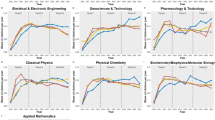Abstract
Temporal differences in self-citing and self-cited rates of journals are studied. It is concluded that the citation curve of a journal is composed of two curves with different characteristics: a self-citation (or self-cited) curve and a curve representing external citations.
Similar content being viewed by others
References
R. Tagliacozzo, Self-citations in scientific literature,Journal of Documentation, 33(4) (1977) 251–265.
S. M. Lawani, On the heterogeneity and classification of author self-citations,Journal of the American Society for Information Science, 33(1982) 281–284.
M. Yitzhaki, The ‘language preference’ in sociology: measures of ‘language self-citation’, ‘relative own-language preference indicator’, and ‘mutual use of languages’. In:Proceedings of the sixth conference of the international society for scientometrics and informetrics, Jerusalem, Israel, 1997,Peritz andEgghe, (Eds), Jerusalem: Hebrew University, 505–515.
S. P. Harter, T. E. Nisonger, A. Weng, Semantic relationships between cited and citing articles in library and information science journals,Journal of the American Society for Information Science, 44(9), (1993) 543–552.
P. Ingwersen, The calculation of Web impact factors,Journal of Documentation, 54(2) (1998) 236–243.
R. Rousseau, Sitations: an exploratory study,Cybermetrics, 1(1) (1997)http://www.cindoc.csic.es/cybermetrics/articles/vli1pl.html
H. Zhang, S. Yamazaki, Citation indicators of Japanese journals,Journal of the American Society for Information Science, 49(4) (1998) 375–379.
L. Sharma, Mapping the citation link of journals in condensed matter physics. In:Proceedings of the fifth biennial conference of the international society for scientometrics and informetrics Rosary College, River Forest, IL, 1995,Koenig andBookstein (Eds.) Medford (NJ): Learned Information, 515–524.
L. Egghe, R. Rousseau,Introduction to Informetrics. Quantitative methods in library, documentation and information science, Amsterdam: Elsevier, 1990.
E. Spinak,Diccionario enciclopédico de bibliometría, cienciometría e informetría. Caracas (Venezuela). Unesco, 1996.
D. F. Kohl, C. H. Davis, Ratings of journals by ARL library directors and deans of library and information science schools.College & Research Libraries, 46 (1985) 40–47.
M. T. Kim, Ranking of journals in library and information science: a comparison of perceptual and citation-based measures,College & Research Libraries, 52(1) (1991) 24–37.
R. Todorov, W. Glänzel, Journal citation measures: a concise review,Journal of Information Science, 14 (1988) 47–56.
A. Schubert, T. Braun, Reference standards for citation based assessments,Scientometrics, 26(1) (1993) 21–35.
H. Maczelka, S. Zsindely, All well if starts well? Citation infancy of recently launched chemistry journals,Scientometrics, 25(2) (1992) 367–372.
L. Leydesdorff,The challenge of scientometrics, Leiden: DSWO Press, 1995.
R. J. W. Tijssen, J. De Leeuw, A. F. J. Van Raan, A method for mapping bibliometric relations based on field-classifications and citations of articles. In:Informetrics 87/88,Egghe andRousseau (Eds.). Amsterdam: Elsevier, 1988, 279–292.
E. Noma, An improved method for analyzing square scientometric transaction matrices,Scientometrics, 4(4) (1982) 297–316.
W. S. Lyon, Scientometrics with some emphasis on communication at scientific meetings and through the “Invisible College”,Journal of Chemical Information and Computer Science, 26 (1986) 47–52.
R. Rousseau,A scientometric study of the scientific publications of LUC (Limburgs Universitair Centrum). Period 1984–1996. Report:LUC, 1998.
R. Rousseau, Yearley differences between self-cited and self-citing rates of scientific journals,Fifth International Conference on Science and Technology Indicators (Hinxton, Cambridge, England). Book of Abstracts, (1998) 101–102.
L. Egghe, I. K. R. Rao, Citation age data and the obsolescence function: fits and explanations,Information Processing and Management, 28 (1992) 201–217.
R. Rousseau, A note on maximum impact factors. In:Information as a global commodity: communication, processing and use. CAIS/ACSI '93 (21st Annual Conference Canadian Association for Information Science) 1993, 120–124.
A. Tahai, J. T. Rigsby, Information processing using citations to investigate journal influence in accounting,Information Processing and Management, 34 (1998) 341–359.
R. Rousseau, Convolutions and their applications in information science,Canadian Journal of Information and Library Science, (1998) to appear.
C. Y. K. So, Openness index and affinity index: two new citation indicators.Scientometrics, 19 (1990) 25–34.
H. P. F. Peeters, A. F. J. Van Raan, A bibliometric profile of top-scientists. A case study in chemical engineering.Scientometrics, 29(1) (1994) 115–136.
W. Glänzel, U. Schoepflin, A bibliometric study on ageing and reception processes of scientific literature.Journal of Information Science, 21 (1995) 37–53.
E. Garfield, The impact factor,Current Comments, June 20, 1994.
L. Egghe, R. Rousseau (1998). Comparing self-citation curves with global citation curves, (in preparation).
J. R. Green, D. Margerison,Statistical treatment of experimental data. Amsterdam: Elsevier, 1978.
Author information
Authors and Affiliations
Rights and permissions
About this article
Cite this article
Rousseau, R. Temporal differences in self-citation rates of scientific journals. Scientometrics 44, 521–531 (1999). https://doi.org/10.1007/BF02458493
Received:
Issue Date:
DOI: https://doi.org/10.1007/BF02458493




